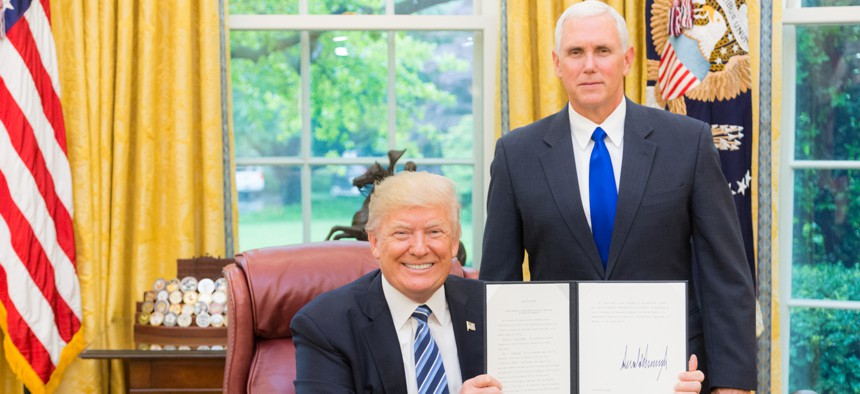Sometimes, Executive Orders Are No More Powerful Than Tweets
Orders can be issued with the stroke of a pen. Implementing them is another matter.
After President Trump granted clemency to disgraced Navy SEAL Eddie Gallagher earlier this month, the Navy acted to remove Gallagher from the SEALs. The president tweeted his disapproval, to which a Navy spokesman responded that the service “follows the lawful orders of the president," and said they were awaiting further guidance. So did the tweet constitute an order? The Navy seemed skeptical.
It might not surprise you that a presidential tweet generates confusion, but how about an executive order? Modern presidents favor such orders because they offer an opportunity for unilateral action. But a comparison of two recent executive orders reveals that not all of them are built to last.
In October the president signed two orders that aimed to change the way agencies use a wide range of materials known as “guidance documents.” This is a category of government activity that often goes unnoticed by the public, in part because of the way such documents are created and distributed.
Guidance documents are different from formal rules. To make new rules or change existing ones, federal agencies have to propose something new, take comments from the public, and then finalize the new policy in the Federal Register. There are exceptions for certain rules, but that’s the basic process.
Guidance documents could not be more different. This is, in part, because they can be formal written documents, but they can also be internal manuals, speeches, letters, and even webinars, blog posts, frequently asked questions pages on websites, and more. They are generated in different parts of agencies, and while they might undergo some internal vetting, it is a very rare for agencies to put these documents out for public comment before releasing them as final. And good luck finding them all.
The differences between rules and guidance aren’t necessarily bad. Rules are special because they have the force of law. Failing to follow one can lead to enforcement action including criminal sanctions in some cases. Guidance documents, on the other hand, do not have the force of law—or at least they’re not supposed to. That’s where the new executive orders come in.
The first order changes the way agencies produce and publish guidance documents. It gives them a short period of time to round up their guidance, decide what to keep, and then display what’s left on a single website or database. Agencies must also send some new guidance documents through the Office of Information and Regulatory Affairs at the Office of Management and Budget for review before releasing them to the public for comment.
The second order places limits on agency use of guidance documents in certain legal proceedings. This gets at the concern that agencies were using such documents improperly, such as by trying to charge someone with a violation when the rules were murky but the guidance was more precise.
Each order attempts to limit agency use of guidance documents but uses different methods. In the first order, the president tasked OIRA with telling agencies what to do and reinvigorated a process for OIRA to review some new guidance documents. This checkpoint authority is what gives the first order a fighting chance of being implemented with vigor, especially because OIRA is mostly comprised of long-serving career staff rather than temporary political appointees.
The second order tells agencies what to do and includes deadlines, but it is not clear who will enforce them. The government is vast and agencies have many responsibilities. Political appointees come and go with their own priorities. Without someone to keep the agencies moving forward on any new initiatives, it’s not clear how this order will actually change agency behavior.
Plus, if a regulated party wants to challenge an agency’s use of guidance, how would they do it? Executive orders are generally not enforceable by the courts. The Justice Department gets involved in some agency enforcement actions, but the order does not give the department any new oversight role. So whose job is it to make sure this order actually changes day-to-day agency practice? The order doesn’t say.
Presidents like executive orders because they can be issued with the stroke of a pen. They are not, however, implemented so easily. Anything that involves a change in behavior will encounter resistance—not necessarily because the idea is bad, or because the rank and file is subversive, but because humans face competing demands and greatly favor the status quo. Any tweet or executive order can only be one piece of a larger effort to change the way government operates.
Bridget C.E. Dooling (@BridgetDooling) is a research professor at The George Washington University Regulatory Studies Center and former deputy chief at the Office of Information and Regulatory Affairs.



